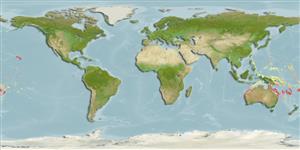Teleostei (teleosts) >
Argentiniformes (Marine smelts) >
Argentinidae (Argentines or herring smelts)
Etymology: Glossanodon: Greek, glossa = tongue + Greek, anodos = without teeth (Ref. 45335).
Eponymy: Dr Paul James Struhsaker (1935–2018) was a fishery biologist and ichthyologist. [...] (Ref. 128868), visit book page.
More on author: Cohen.
Environment: milieu / climate zone / depth range / distribution range
Ecology
Marine; benthopelagic; depth range 185 - 373 m (Ref. 58302). Temperate; 23°N - 30°S, 112°E - 153°W
Western Central Pacific: Australia (Ref. 7300). Eastern Pacific: Hawaiian area (Ref. 583).
Size / Weight / Age
Maturity: Lm ? range ? - ? cm
Max length : 11.0 cm SL male/unsexed; (Ref. 31667)
Occurs on the outer shelf and upper slope, rarely to 1400 m.
Life cycle and mating behavior
Maturity | Reproduction | Spawning | Eggs | Fecundity | Larvae
Paxton, J.R. and D.M. Cohen, 1999. Argentinidae. p. 1884. In K.E. Carpenter and V.H. Niem (eds.) FAO species identification guide for fishery purposes. The living marine resources of the WCP. Vol. 3. Batoid fishes, chimaeras and bony fishes part 1 (Elopidae to Linophrynidae). FAO, Rome. (Ref. 9857)
IUCN Red List Status (Ref. 130435: Version 2024-2)
Threat to humans
Harmless
Human uses
Fisheries: of no interest
Tools
Special reports
Download XML
Internet sources
Estimates based on models
Preferred temperature (Ref.
123201): 17.8 - 21.2, mean 18.9 °C (based on 16 cells).
Phylogenetic diversity index (Ref.
82804): PD
50 = 0.5001 [Uniqueness, from 0.5 = low to 2.0 = high].
Bayesian length-weight: a=0.00363 (0.00163 - 0.00807), b=3.17 (2.98 - 3.36), in cm total length, based on LWR estimates for this (Sub)family-body shape (Ref.
93245).
Trophic level (Ref.
69278): 3.1 ±0.3 se; based on size and trophs of closest relatives
Resilience (Ref.
120179): High, minimum population doubling time less than 15 months (Preliminary K or Fecundity.).
Fishing Vulnerability (Ref.
59153): Low vulnerability (10 of 100).
